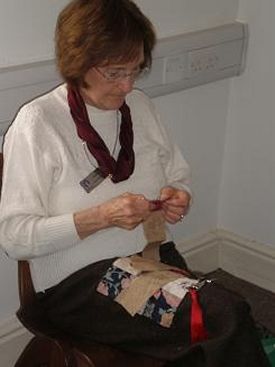Volunteers Sew Replicas of Heritage Quilts
Published: Wednesday, 2nd December 2009 16:14 PM

A team of volunteers at the Quilt Museum and Gallery have been sewing replicas of heritage quilts in the 'Warp, Weft, and the Printer's Block' exhibition. The project has been enjoyable and challenging. Read further to find out what it really takes to make a replica of a 19th century quilt.
Interview with volunteers Christine Manning and Glenda Smith by Lauren DeVos
1. Which quilts are you currently making replicas of?
The Nine Patch Quilt and the Lugley House Coverlet
2. What have you enjoyed about this project?
Sitting and sewing is always enjoyable but it makes you look at the quilts more closely and studying the way it was put together and what fabrics were used. It is also nice to feel that you are doing something useful for people to handle and also to create a quilt in the same way that it would have been done.
3. What have you learned from this project?
When they were sewing they were not that accurate with the lines and corners. Most of the corners do not meet up exactly. Most of the time it was done completely by eye so the lines are not completely straight. Also, they were not making these quilts for display but rather for warmth and out of whatever materials they had around the house. With modern quilting you use rulers and everything is very exact so it is interesting to see how different the style of quilting was.
4. What has surprised you about this project?
Just how difficult it is to copy these quilts. There is a huge store of materials to choose from but it is still very time consuming and difficult to find materials that are near to the colouring and style of the fabrics. We have spent a long time searching through the fabrics and still haven?t been able to match them all.
5. What materials are you using? Were they difficult to obtain?
We are using mostly cottons and lawns. The colouring is subdued and the patterns are mostly smaller. We are trying to match the colouring and patterns as much as possible but it is very difficult to do that. Most modern fabrics, even when you can find patterns that match, are too bright to use. The original fabrics used for the quilts were old already because they were what were available. They were most likely old dresses or shirts. The problem is that the material donated to the museum is not generally what the quilts were made out of. People don?t really donate old dresses and shirts so the selection is not what the original fabrics would have been. Also, the quilts are faded so even if you were to find a fabric that is very similar the colouring is too bright. We have even tried tea staining fabrics to make them look older but it still doesn?t look right. It is also a very slow going project. We are trying to make these replicas as authentic as possible and doing everything by hand in the same style is very slow going.
6. What techniques are you learning to make the replica quilts?
I call this style English Paper Piecing and it is one of the oldest most traditional ways of making a quilt. You fold the fabric over paper and sew the squares together then remove the paper.
Thank you to all of the volunteer Gallery Stewards who have contributed to this project by sewing hexagons; it has been a terrific team effort!
If you would like to help with sewing replica quilts for future exhibitions, or donate fabric for this project, please contact the Volunteer Organiser at 01904 613 242 or volunteer@quiltmuseum.org.uk.